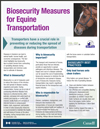Transporters have a crucial role in preventing or reducing the spread of diseases during transportation. Diseases in livestock can lead to animal health, human health, and economic consequences. This fact sheet highlights key biosecurity tips to protect horses from contracting or spreading diseases during transportation and minimize costs due to outbreak of diseases.
What is biosecurity?
Biosecurity is a set of measures used to reduce the chance of the introduction and spread of disease-causing organisms and pests. During transportation, horses can be at risk of contracting infectious disease from exposure to infected horses, other animals, carcasses and pests (such as rodents and insects) or contact with manure, bodily fluids and aerosols of infected horses or contaminated trailers, tack, equipment, and people. A chain of strict biosecurity measures is recommended to maintain the health and well-being of horses at the place of loading, during transportation and at the destination site.
Why is biosecurity important?
The transport and movement of horses, particularly those that are infected, provide an opportunity to spread pathogens and infectious diseases. The impact and cost of a disease outbreak can far exceed the cost of implementing biosecurity measures to minimize the risk of introduction and spread of disease. Lack of biosecurity measures during transportation may result in significant financial loses for the transporters and equine industry.
Who is responsible for biosecurity?
Owners, caretakers, transporters, and everyone else involved in the transportation of horses are responsible for ensuring animal health and welfare. It is recommended that biosecurity measures be implemented at all times during loading, on the road and during unloading. Always discuss biosecurity with the horse owner or custodian before transportation.
General Biosecurity Recommendations
- Plan your transportation event.
- Determine and follow biosecurity protocols for departure and destination sites. Respect and follow posted biosecurity signs.
- When accessing sites, avoid muddy or manure-contaminated pathways. Drive slowly to minimize contamination of the undercarriage of the trailer.
- Whenever possible, select routes that avoid locations where a disease is identified. Follow disease outbreak updates provided by the CFIA, USDA, and provincial or state governments.
- Clean out (scrape) all organic waste, including bedding, feed and manure a designated scrape-out location or at the destination site in case of farms.
- Enhanced biosecurity measures are required in situations where disease is suspected or has been identified.
- It is recommended that transporters be aware of signs of disease and fitness for transport.
Biosecurity Best Practices
Only load horses onto clean trailers
Dirty trailers can spread disease. To reduce the risk of spreading disease:
- Clean and disinfect trailers between transportation events.
- Use effective and compatible cleaning (detergents, degreasers) and disinfection products; consult specialists as needed. Ensure that trailer surfaces are visually clean and free of all organic matter before applying the disinfectant. Follow label directions.
- Before loading, inspect the trailer to ensure that it is dry and clean.
Avoid contact with other horses or animals
Animals can appear healthy yet still shed pathogens (e.g. bacteria, viruses, and fungi) that can put other horses at risk of infection. To reduce this risk:
- Whenever possible, avoid transporting horses from multiple farms.
- Transport horses of equal health status. It is in the interest of the owners that their horses be appropriately vaccinated.
- Avoid transporting sick horses. If necessary, transport sick horses separately and under the advice of a veterinarian.
- As much as possible, prevent horses within your shipment from interacting with other horses or animals.
- Whenever possible, at rest stations or commingling sites park away from other horses or livestock trailers.
People and equipment
People and equipment that have come into contact with diseased animals or their environment can pose a risk to your horse. To minimize this risk:
- Whenever possible, use designated equipment (e.g. shovels, feed and water buckets). Clean and disinfect all equipment after use.
- Do not share equipment with others or use it for other purposes.
- People who come into contact with the horses being transported must wear clean clothing and footwear.
- Always clean and sanitize hands before and after contact with the horses, other animals or horse equipment.
- Use bedding that is clean and free of contaminants. Whenever possible, do not reuse bedding between transportation events.
- Discourage people not involved with the transport from coming into contact with the horses, equipment and horse trailer.
- Keep the power unit clean to minimize cross-contamination between transportation events.
For more information, visit the biosecurity standard for livestock, poultry and deadstock transportation on the Canadian Food Inspection Agency website at Inspection.gc.ca and Canadian Animal Health Coalition website at Animalhealth.ca.
